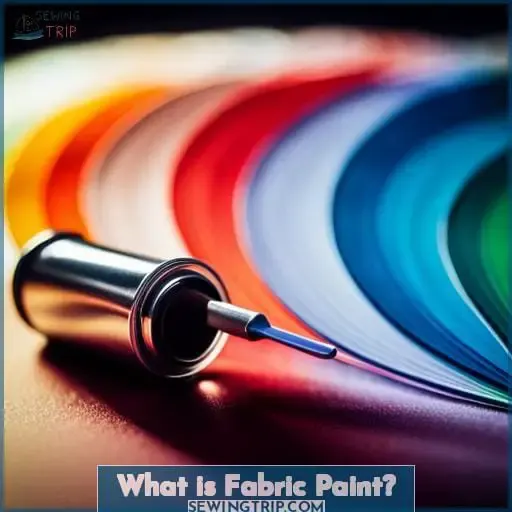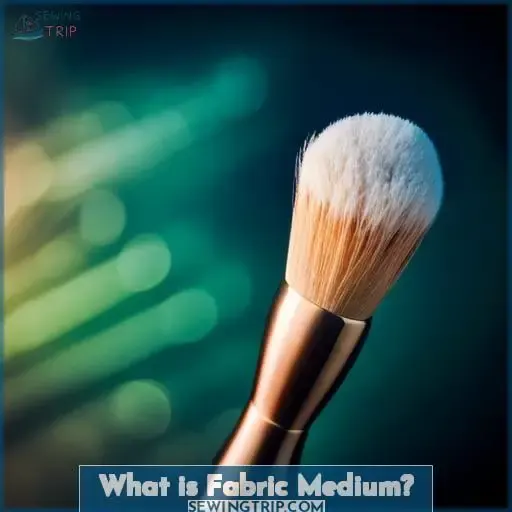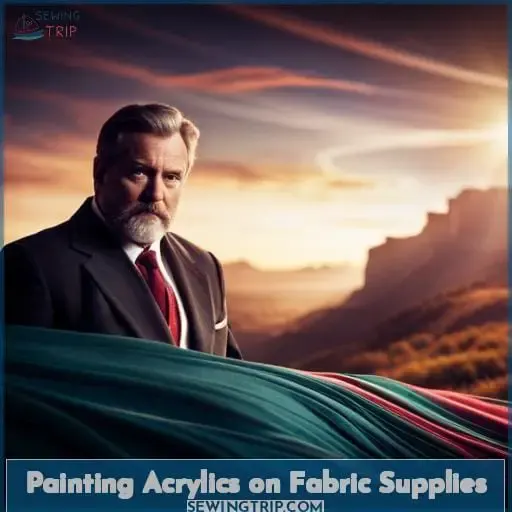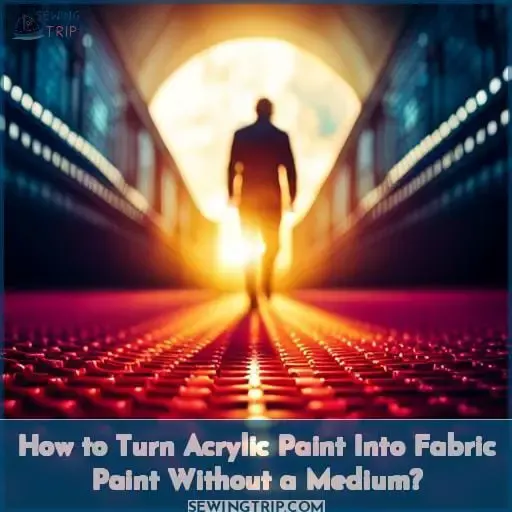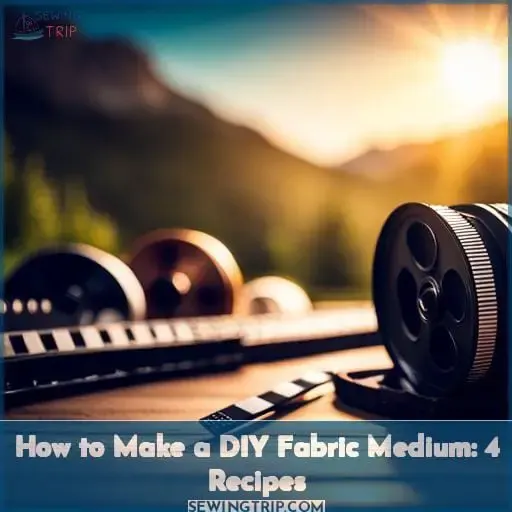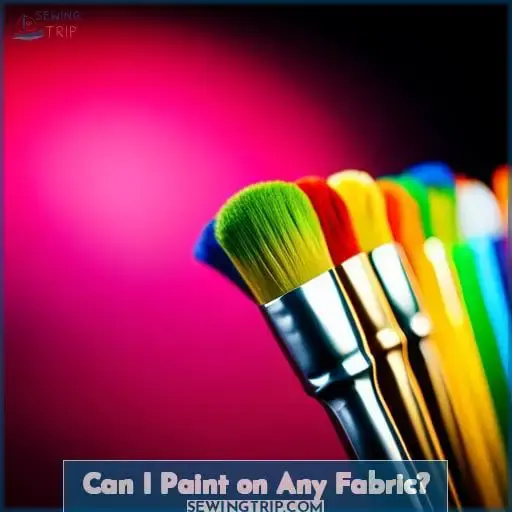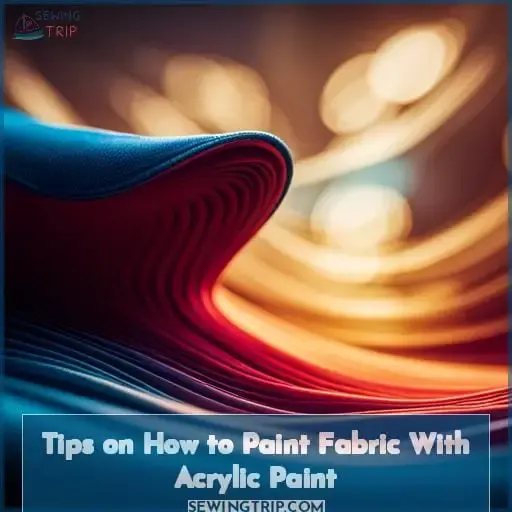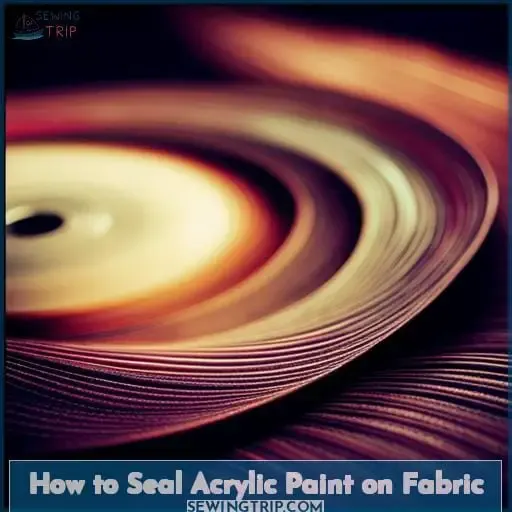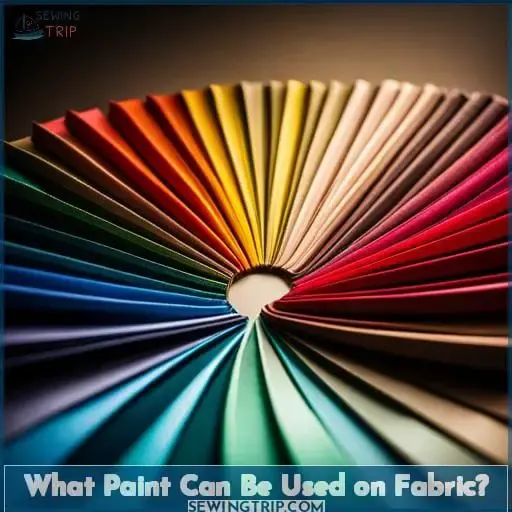This site is supported by our readers. We may earn a commission, at no cost to you, if you purchase through links.
Start your fabric painting journey with just a few supplies and some creativity! With the right tools, you can turn acrylic paint into fabric paint without needing any medium. And best of all, you don’t even need to be an expert painter or crafter to do it.
All that is required is a little know-how, and before you know it – voila! – You’ll be transforming old clothes and fabrics into unique masterpieces like never before. To get started on this exciting adventure of turning acrylics into fabric paints without mediums requires only two things: supplies such as glycerine, white vinegar, or water; plus knowing how to combine them correctly with your chosen type of acrylic paint in order for optimal results.
Read on to find out everything about how these simple ingredients work together in order to transform ordinary materials into extraordinary art pieces!
Table Of Contents
- Key Takeaways
- What is Fabric Paint?
- What is Fabric Medium?
- Painting Acrylics on Fabric Supplies
- How to Turn Acrylic Paint Into Fabric Paint Without a Medium?
- How to Make a DIY Fabric Medium: 4 Recipes
- Can I Paint on Any Fabric?
- Tips on How to Paint Fabric With Acrylic Paint
- How to Seal Acrylic Paint on Fabric
- What Paint Can Be Used on Fabric?
- Frequently Asked Questions (FAQs)
- Conclusion
Key Takeaways
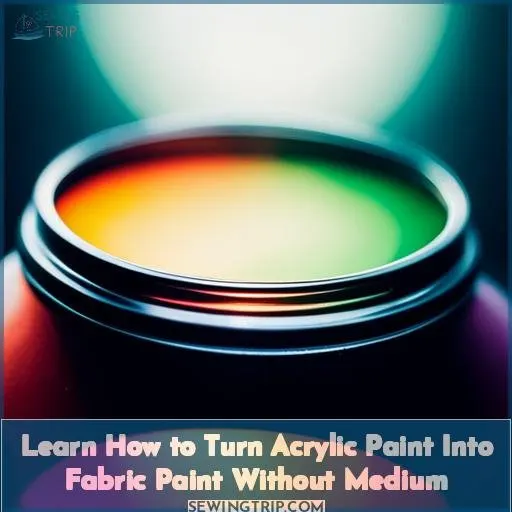
- Acrylic paint can be turned into fabric paint without needing any medium.
- Glycerin, white vinegar, or water can be used to combine with acrylic paint for fabric painting.
- Fabric paints are permanent and colorfast, suitable for painting, block printing, stenciling, or stamping.
- Heat setting is necessary for longer-lasting results.
What is Fabric Paint?
Make your fabric projects come alive with the vibrant colors of fabric paint – offering a soft hand and laundering stability, this is an easy way to add unique touches to any project! Fabric paints are permanent and colorfast, providing semi-transparent and intense colors that can be used for painting, block printing, stenciling, or stamping.
Dye offers better absorption into fabrics, but acrylic paint can also be used on fabric without medium by sanding the surface first, then spraying with water. Acrylics provide brighter colors than dyes, while pale shades may need another thin layer of diluted acrylic mixed with less fabric medium.
Heat setting ensures longer-lasting results, so wait at least 24 hours before heat setting, then 4-5 days before washing in cold water inside out using a gentle cycle or hand wash, adding some mild detergent for the best result, avoiding pre-soaking as it could cause damage to the design.
Iron on the wrong side, protecting the iron board from direct contact using low-temperature settings if needed, especially when dealing with delicate materials like suede, which should remain dry cleaned.
Proper care is necessary for maintaining painted designs, such as avoiding spot cleaning solutions, sunlight exposure, in order not to fade pigments. Use protective coatings, sealers, and even vegetable glycerin moisturizer over painted areas to help prolong the lifespan of artwork created, whether dye-based or made from acrylics, including DIY techniques mixing regular paints through textile medium along flow aid additive makes softer edges compared to hard lines given by wax resist technique.
Both offer great potential to personalize pieces, transforming them into eye-catching masterpieces worthy of admiration.
What is Fabric Medium?
Fabric medium is a liquid additive that boosts the adhesion of acrylic paint on fabric, giving it increased flexibility and softness for stunning results. It also helps to prevent colors from bleeding and improves the longevity of painted designs.
Fabric dyes are usually used for better absorption into fabrics, but with fabric medium, you can use regular acrylic paints as well without worrying about stiffness or roughness afterwards. The type of fabric will determine which kind of pouring medium to choose. There are special formulas designed specifically for different types such as cotton, polyester, or suede material.
For best results when using Liquitex Fabric Medium, dilute 1 part per 8 parts paint before applying onto your chosen surface. Then heat set after 24 hours have passed in order to protect pigments against fading over time if exposed too much sunlight exposure, either directly or indirectly through windows, etcetera.
Once complete, make sure you seal the design by brushing some sort of protective coatings like Mod Podge Gloss Sealer Glue on top so that any dirt residue won’t be able to penetrate inside, thus preserving its beauty longer than expected! Finally, don’t forget to add a teaspoonful amount of fabric softener during the washing process while using a gentle cycle at room temperature.
Painting Acrylics on Fabric Supplies
For painting acrylics onto fabric, you’ll need the right supplies to ensure your design lasts and looks great.
Fabric Care Tips:
Selecting the correct type of fabric is important when working with paint, as some fabrics may not react well with certain mediums or colors. Be sure to research all fabric care tips before starting any project! Additionally, be aware that iron heat will help set your paints, giving them durability over time, but it should always be done on low heat settings.
DIY Mediums:
Making DIY medium solutions at home can give you more control over how much flexibility and softness are achieved in the final product. Acrylic paints by themselves don’t have UV resistance, so mixing them with an acrylic medium like Liquitex Fabric Medium or Delta Creative Ceramcoat Paint helps improve results while controlling bleeding colors and adhesion issues too!
Craft Paints & Spray Paints:
When using craft paints such as Apple Barrel Acrylic Paint Set or Martha Stewart Tintable Paint along with spray paint from brands like Mr Pen Tailor’s Chalk 8 Pack, you can add extra detail into designs, allowing you to create unique pieces without having to worry about damaging materials due to their potent pigments content in each bottle/canister respectively. However, note that these products must only be used outdoors away from direct sunlight exposure, otherwise fading might occur sooner than expected!
Heat Sealing & Aftercare Tips For Fabrics:
Heat sealing can extend the life of painted fabrics for up to 5 years, depending on the types of materials used prior during the construction phase (e.g., Polyester). Yet, it still requires proper aftercare methods, which include washing inside out, spot cleaning if necessary, gentle cycle machine wash, then tumble dryer at room temperature, etc., when available options present themselves accordingly – avoiding pre-soaking garments beforehand also helps maintain vibrant hues alive for longer periods. Plus, adding a small amount of liquid detergent alongside a few drops of vegetable glycerin moisturizer solution is recommended for ENTs dealing with Dry Mouth problems known medically as Oral Lichen Planis, ensuring further protection against unwanted dirt particles sticking to the clothing surface areas gently.
With this guide, anyone has what they need for creating stunning projects featuring beautiful paintings using acrylic paint directly onto any choice textile surfaces imaginable – even ones previously thought ‘impossible’ are now doable thanks to advances in technology combined with the ease of access to high-quality materials that today’s market offers consumers everywhere!
How to Turn Acrylic Paint Into Fabric Paint Without a Medium?
Ready to turn your acrylic paint into fabric paint without a medium? Let’s explore the possibilities! We’ll look at how to make fabric medium, whether you can mix vinegar and acrylic paint for fabric painting, what to keep in mind when using vinegar as a substitute for fabric medium, if it’s possible to use softener as an alternative option instead of traditional fabric’s time-consuming methods like pouring milk or adding detergent.
Finally, we’ll discuss if pouring medium is the same thing as traditional fabric media.
How to Make Fabric Medium?
Using a fabric medium when painting with acrylics can help give your project the perfect look and feel for years to come. DIY fabric medium is easy to make from a blend of liquid acrylic paint, an acrylic polymer liquid, and water.
Heat setting this mixture helps it adhere better to fabrics like cotton or polyester t-shirts. Vinegar can be used as a substitute softener if desired but should not replace more than half of the water needed in the mix.
Finally, adding small amounts of flow aid additive will further improve results without compromising the flexibility and softness achieved by using traditional fabric medium solutions available commercially today!
Can I Mix Vinegar and Acrylic Paint for Fabric Painting?
You can mix vinegar with acrylic paint to create a fabric painting that will last long-term and maintain its vibrancy, while adding a subtle softening effect for stiffer fabrics. Pouring Medium or fabric softener should be added when using heavier-bodied paints.
Heat treating is also recommended after application to ensure the best results on your fabric painting project.
Specialty textile paints may require more attention as their shelf life is shorter than normal acrylics, so it’s important to use lightweight fabrics if you want maximum longevity from your artwork! With careful planning and use of the right products, you’ll have beautiful results in no time – perfect for any special fabric painting project!
A Quick Note About Vinegar
Vinegar can be used to add a softening effect when creating fabric paintings, but caution should always be taken as it may discolor if not used correctly. It offers several benefits. Mixing vinegar with acrylic paint creates a special blend that will last longer than normal paints.
Pouring mediums or fabric softeners are great alternatives to using heavier-bodied paints. DIY recipes, such as adding a little water in sketch, use sewing chalk for the perfect combination of components.
To make sure your painting lasts long-term, spray bottle room temperature water over your design before heat setting it.
Can I Use Fabric Softener as Fabric Medium?
Try using fabric softener as a fabric medium to get the perfect blend for your next painting! Fabric softeners come in various types and provide great safety benefits when used on fabrics. With its dilution properties, it prevents dry fabrics from being damaged by paint while also helping paints adhere better.
An alternative is distilled water, which helps thin out the paint without affecting color intensity. For more specific effects, special fabric medium can be bought or you can make simple ones with common household items like white glue and baby oil.
When applying any of these solutions to your painting surface, be sure that it’s completely dry before proceeding with other steps such as heat setting or washing instructions.
Proper usage of fabric softener gives projects an extra boost of vibrancy along with durability so they last longer than ever before – just don’t forget to use a good quality brush or sponge for even coverage and avoid harsh chemicals like bleach if possible!
Is Pouring Medium the Same as Fabric Medium?
No matter what your project is, it’s important to know if pouring medium is the same as fabric medium before getting started. Fabric medium helps with acrylic adhesion on fabrics and also prevents dry fabrics from being damaged by paint.
Pouring medium, however, has a different purpose. It helps create abstract artworks for professional artists or modern DIY projects! This unique product can be used in combination with other materials like fabric softener for added flexibility when working with paints and dyes.
For best results, choose a bottle of quality fabric medium designed specifically for use on textiles.
How to Make a DIY Fabric Medium: 4 Recipes
Creating fabric paint from acrylic is easier than you might think, and with a few simple steps, you can make your own DIY fabric medium to get started.
- Mix one part acrylic paint with two parts glycerin mix, stirring until the mixture becomes smooth. This makes an excellent fabric medium that will give your painted piece a soft feel and prevent colors from bleeding into each other while also improving adhesion of the paints on the fabric surface.
- Heat setting is another great way to improve results when using traditional acrylic paints as good quality fabric media without any additives or extra ingredients like wax resist or Flow-Aid Additive used in some professional studios are still prone to cracking after painting on them if not heat set properly, so it’s important not to forget this step before washing your finished work of art!
- You can also use liquid Fabric Softener as an alternative option instead of spending time preparing milk pourings, which usually require days till they dry out completely – just add 10 drops per 1 cup (80g) of water, then allow it to sit overnight before adding Acrylic Paint directly into this solution for maximum effect!
- A pouring Medium is yet another way craft artists use when working with Acrylic Paints – although its purpose may seem similar at first glance, these products differ greatly. Since their main task here would be creating even layers without affecting color vibrancy too much, unlike what we’ve seen previously mentioned options do best – helping preserve vibrant hues over long-term usage by protecting against fading due to UV light exposure, etcetera.
No matter how you choose to create homemade Fabric Media, all things considered, there are certain precautions every artist should take, such as prewashing material prior to starting painting, cleaning tools afterwards, and waiting at least four to five days until washing the final product in order to ensure a longer-lasting design result possible.
Can I Paint on Any Fabric?
You can make your fabric projects truly unique by adding a personal touch with acrylic paint, but it’s important to consider the type of fabric you plan on painting. Not all fabrics are suitable for painting, and some may require special preparation or care afterwards.
To help you choose the best fabric for your project, here is a table outlining different types of fabrics and their compatibility with acrylic paints:
| Fabric Type | Best Fabric Mediums | Use Of Steam Settings? | Care After Painting | Paint Choice | Special Preparation |
|---|---|---|---|---|---|
| Lightweight Cotton | Liquitex/Delta Creative Ceramcoat | Yes | Hand washable | Low Sheen Acrylic | No |
| Denim | Jacquard Professional Quality | No | Machine Washable | High Gloss Acrylic | Pre-soak in hot water before washing |
| Leather | Mod Podge Gloss Sealer Glue | Yes | Dry Clean Only | Metallic & Pearlized Acrylic | Sand surface first before application |
| Synthetic Fibers | Apple Barrel Set 8 oz | No | Spot Cleaning | Matte Finish Paint | Treat stains first with mild detergent |
| Suede | Martha Stewart Tintable Paint – White | Yes | Dry clean only | Watercolor Technique | Add wax resist for hard edges |
| Faux Fur | NOW Vegetables Glycerin Moisturizer 16oz | N/A | Brush lightly | Low Viscosity Colors | Dilute colors as needed |
Tips on How to Paint Fabric With Acrylic Paint
To craft your own fabric designs with acrylic paint, learn the tips and tricks for using a variety of mediums to achieve stunning results – no matter what material you’re working on.
- Make sure to mix in the correct amounts of acrylics and medium for the best results. Heat setting can be used to set colors permanently, but caution should be taken when pre-soaking fabrics as certain dyes may run off or fade.
- Take special care when painting UV-sensitive fabrics such as silk or leather; use a sealer after heat setting for extra protection from sunlight damage. Specialty paints like metallic and pearlized acrylic will also add detail while offering better durability than standard paints.
- For larger projects that require plenty of coverage, choose heavy body acrylics rather than thin washes so that it does not take multiple coats just to get enough opacity onto the surface.
By following these simple steps, you’ll ensure an enjoyable experience creating custom patterns on any kind of fabric – whether lightweight cotton or thick faux fur! Just remember proper care is essential once finished: hang pieces out flat away from direct sunlight until completely dry before washing/ironing (if necessary).
How to Seal Acrylic Paint on Fabric
Are you looking for the best way to seal acrylic paint on fabric? If so, then this article is perfect for you! From denim and shoes to fabrics of all kinds, we’ll discuss how to use acrylic paints with or without mediums.
We’ll also explore some of the best types of acrylic paint specifically designed for fabric projects.
How to Seal Acrylic Paint on Denim
Finish off your denim look with a custom-painted design and seal it in for long-lasting vibrancy! To get the best results, choose acrylic paint that’s specifically designed for fabric. Heat setting is key for better adhesion; use low heat on delicate fabrics like silk or leather.
For protection against UV rays, add a sealer after heat setting. Different sealing techniques work best depending on the type of fabric you’re working with – cotton versus synthetic materials, etcetera – so make sure to research before getting started!
Washing tips also vary per fiber type; hand wash and drip dry when possible or go slow if machine washing/drying is necessary (use the gentle cycle). Get creative with painting techniques such as wax resist or diluted Flow Aid Additive to achieve soft edges.
Follow these steps carefully and enjoy showing off your own unique designs on denim pieces while they stay vibrant over time!
How Do I Heat Treat Shoes?
Take your shoes to the next level with some heat-treating like a pro, just as smooth and effortless as butter! Dry cleaning is often recommended for shoes, but if you’d rather do it yourself at home, heat setting can help.
For best results, use low temperatures on delicate fabrics. If you’re using an iron or steamer on painted sections of your garment, be sure to protect them first with clean fabric and set the temperature accordingly – usually warm to hot, depending on the fiber type.
To avoid pre-soaking or spot cleaning solutions damaging any paintwork, try opting for a gentle press wash instead, followed by air drying away from direct sunlight if possible. Machine washing in large options should also be avoided when dealing with acrylic paints.
Don’t forget that proper care will ensure long-lasting vibrancy!
BEST ACRYLIC PAINT FOR FABRIC
Experimenting with the right acrylic paints can help bring out the best in your fabric projects. Mixing acrylics with fabric softener or vinegar paint is great for controlling colors from bleeding and enhancing adhesion.
Most versatile paints stay bright after washing, so pre-washing fabrics first is essential for cotton-poly blends. To get the best results, add a good quality fabric softener during the wash cycle and use low heat when ironing on the wrong side of the garment.
With these simple tips, you’ll be sure your painted designs are sealed and long-lasting!
Best Acrylic Paint to Use on Fabric(with or Without Medium)
Discover the best acrylic paints to use on fabric, with or without fabric medium, and achieve high-quality results that will last through many washes. Sanding fabric before using a thick mix of paint can help prevent cracking while adding UV resistance.
Use caution when bleaching white fabrics, but if done correctly, you’ll be sure your painted designs are sealed! Adding a few ml of glycerin mix to your paint can also help with absorption and adhesion.
Heat setting is key after painting. Set the iron at room temperature on low heat or dry clean for rare washes only.
Best Acrylic Fabric Paint (no Need for Fabric Medium)
Unlock the potential of your fabric projects and bring them to life with professional-grade acrylic paints that don’t require a fabric medium! Try adding a few milliliters of glycerin mix for absorption and adhesion, sanding before application, or using UV-resistant paint.
Heat treating will ensure lasting results. For denim sealing, use smaller sections at one time and longer times when needed due to different absorbency in fabrics.
What Paint Can Be Used on Fabric?
Now that you know how to seal acrylic paint on fabric, it’s time to discuss what kind of paints can be used. When painting with acrylics on fabrics, not just any type of paint will do the job well – certain types are better suited for specific projects and materials.
But before we look at what type of paints work best for fabric projects, let’s take a quick look at the differences between dye and paint so you can make an informed decision when selecting your supplies!
Dyes and acrylic paints both have their own advantages when working with fabrics. Dye is typically better absorbed into most natural fibers than regular acrylics due to its water-soluble properties, which helps colors retain their vibrancy without fading or running even after multiple washes.
However, one main disadvantage is that dyes tend to cost more than standard painted fabrication techniques since they require additional products such as mordants in order for them to penetrate properly into the material being dyed, creating an added expense.
On the other hand, regular acrylic paint brands don’t need special additives, so they offer great value while still producing vibrant colors. However, they may fade slightly faster over time despite using fabric softener during laundering cycles.
It’s also important to note that different brands provide various shades depending upon pigment quality, which makes it easier if you’re looking for something more subtle or bright like neon hues. Just keep in mind that some companies use part glycerin within their formulas, making them less suitable as a craft medium unless heat setting occurs afterwards.
Otherwise, cracking and stiffness could occur once dry, leading to easy deterioration over time.
Additionally, there are other factors such as consistency (thicker/less viscous), opacity (transparent vs opaque), drying times, and whether it’s machine washable, all of which play major roles when deciding upon which brand works best.
The bottom line here, though, is that no matter where your project lies, there are plenty of options available. From Liquitex and Delta Creative to Ceramcoat and Gac 900 Heat Set, FolkArt Textile Medium, Martha Stewart Tintable, Apple Barrel, Mod Podge Gloss Sealer Glue, Mr.
Pen Tailor’s Chalk 8-Pack, and Jacquard Professional Quality Fabric Paint White, these brands offer various degrees of difficulty and ease of application, as well as much longer-lasting results compared to basic methods.
So next time you come across fun and easy painting ideas, always remember these points to ensure a perfect outcome with every single attempt!
Frequently Asked Questions (FAQs)
What are the differences between dye and paint?
Dye and paint both add color to fabric, but dye is better as it soaks in more easily. Dyes provide a deeper, longer-lasting color compared to paints that can be washed away or fade over time. Paints create a thicker layer on the surface of fabric, while dyes penetrate the fibers for a richer hue.
What are the aftercare tips for painted fabric?
After painting fabric, wash it inside out on a gentle cycle and spot clean if necessary. Avoid pre-soaking and use cold water with fabric softener. Hang or dry the fabric at room temperature to prevent cracking and fading of colors.
Iron the fabric on the reverse side using a low heat setting for the best results.
How can I fix stiffness in fabric caused by acrylic paint?
To fix stiffness in fabric caused by acrylic paint, try heat setting, hand washing, and hanging the fabric in a humid area. Additionally, use low heat settings for ironing and protect it from harsh sun to prevent fading.
Do I need to use a fabric medium with acrylic paint?
Yes, you need to use fabric medium with acrylic paint as it improves absorption and prevents stiffness. It also offers a variety of finishes and special effects while ensuring the painted design lasts longer.
Does acrylic paint have UV resistance?
Acrylic paint does not have UV resistance on its own; however, it can be mixed with a fabric medium for added protection from sun damage. With the correct mixture and heat setting, you can enjoy painted fabrics that last longer in harsh conditions.
Conclusion
To wrap up, fabric painting with acrylic paint can be a great way to create unique designs for clothes, accessories, and home decor. With the right supplies, techniques, and know-how, you can make fabric art that is as vibrant and lasting as a rainbow.
If you use the right fabric medium and take the necessary precautions, you can ensure your projects turn out looking as smooth as a freshly painted wall. So don’t be afraid to get creative and start painting! It’s like a blank canvas just waiting to be filled with beautiful designs.

